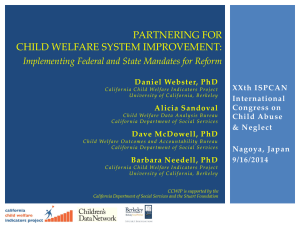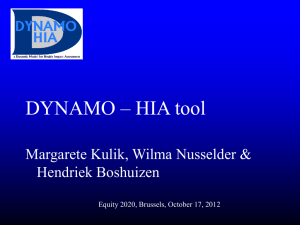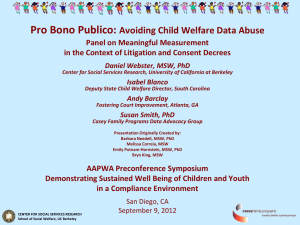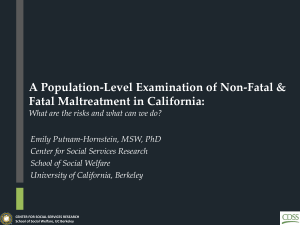NIS–4 - CalSWEC
advertisement
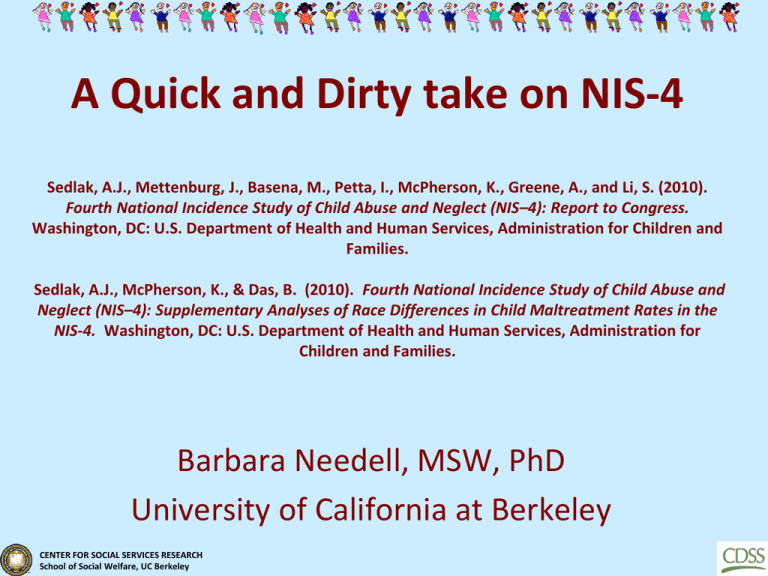
A Quick and Dirty take on NIS-4 Sedlak, A.J., Mettenburg, J., Basena, M., Petta, I., McPherson, K., Greene, A., and Li, S. (2010). Fourth National Incidence Study of Child Abuse and Neglect (NIS–4): Report to Congress. Washington, DC: U.S. Department of Health and Human Services, Administration for Children and Families. Sedlak, A.J., McPherson, K., & Das, B. (2010). Fourth National Incidence Study of Child Abuse and Neglect (NIS–4): Supplementary Analyses of Race Differences in Child Maltreatment Rates in the NIS-4. Washington, DC: U.S. Department of Health and Human Services, Administration for Children and Families. Barbara Needell, MSW, PhD University of California at Berkeley CENTER FOR SOCIAL SERVICES RESEARCH School of Social Welfare, UC Berkeley What is the NIS? • National Incidence Study of Child Abuse and Neglect • Primary objectives – Provide updated estimates of the incidence of child abuse and neglect in the U.S. and measure changes in incidence from earlier studies • Data comes from both CPS reports and “sentinels” CENTER FOR SOCIAL SERVICES RESEARCH School of Social Welfare, UC Berkeley NIS-4 Overview • Data from a nationally representative sample of 122 counties with 126 CPS agencies • Two definitional standards of maltreatment used: Harm Standard and Endangerment Standard • NIS-4 was the first NIS cycle to observe “significant” differences in maltreatment rates according to race CENTER FOR SOCIAL SERVICES RESEARCH School of Social Welfare, UC Berkeley Why did the NIS-4 find differences by race (according to the NIS-4 authors)? • Changes in circumstances for Black and White children from NIS-3 to NIS-4 • NIS-4 had higher precision of estimates of maltreatment than NIS-3 CENTER FOR SOCIAL SERVICES RESEARCH School of Social Welfare, UC Berkeley Changes in Circumstances – Economic CENTER FOR SOCIAL SERVICES RESEARCH School of Social Welfare, UC Berkeley Precision of Estimates CENTER FOR SOCIAL SERVICES RESEARCH School of Social Welfare, UC Berkeley What Changed Between NIS-3 and NIS-4? • Both White and Black Children showed substantial decrease in maltreatment rates over time • % change in rate of White harm standard maltreatment from NIS-3 = -32% • % change in rate of Black harm standard maltreatment from NIS-3 = -24% • A steeper decrease for White Children smaller CIs result in “new” differences by race CENTER FOR SOCIAL SERVICES RESEARCH School of Social Welfare, UC Berkeley Supplementary Analysis • In NIS-4, a SES measure was constructed with 2 categories: -“low” (parents with no high school diploma, less than $15,000 income, or participation in a poverty program) -“not-low” (everybody else) • There was a large amount of missing SES data that had to be imputed (44.9%!!!) CENTER FOR SOCIAL SERVICES RESEARCH School of Social Welfare, UC Berkeley Race Differences and SES • The supplementary report notes that income, or SES, is biggest predictor of maltreatment rates • Many of the race differences in maltreatment rates emerged primarily for physical abuse and were related to SES status • Differences by race were small to nonexistent among children from “low” SES household, but larger among children in “not-low” SES households CENTER FOR SOCIAL SERVICES RESEARCH School of Social Welfare, UC Berkeley …in their own words “Independent evidence indicates that Black and White children very probably have different underlying SES distributions within the NIS–4 non-low SES category, with the not-low SES Black children less well off than the notlow SES White children. If the economic resources of Black and White children had been equivalent in this condition, then the observed pattern of higher risk for Black children under non-low SES conditions may not have emerged. For these reasons, the race differences observed in the notlow SES condition in this report must be interpreted with caution. “ (italics mine) CENTER FOR SOCIAL SERVICES RESEARCH School of Social Welfare, UC Berkeley Why did the NIS-4 find differences by race? Imprecise SES Measures Newly Discovered Differences in Maltreatment Rates By Race More Precise Maltreatment Estimates CENTER FOR SOCIAL SERVICES RESEARCH School of Social Welfare, UC Berkeley Summary/Conclusions • The “increased precision” explanation raises questions about the widespread interpretation of earlier NIS reports • The “income gap” explanation is not yet generally accepted as valid and is under scrutiny • We do not know from NIS-4 if differences would exist independent of SES if more precise demographic measures were used CENTER FOR SOCIAL SERVICES RESEARCH School of Social Welfare, UC Berkeley IMHO • It was wrong to use NIS-1,2,3 to “justify” the need for racial disparities work • It is becoming increasingly clear that SES and race interact • “Why are people poor?” (Undoing Racism trainings) is a very good question, and may hold the key to any understanding of the lack of difference for poor children • The work remains CENTER FOR SOCIAL SERVICES RESEARCH School of Social Welfare, UC Berkeley Barbara Needell bneedell@berkeley.edu 510 290 6334 CSSR.BERKELEY.EDU/UCB_CHILDWELFARE Presentation Developed by Erin Clark CENTER FOR SOCIAL SERVICES RESEARCH School of Social Welfare, UC Berkeley
